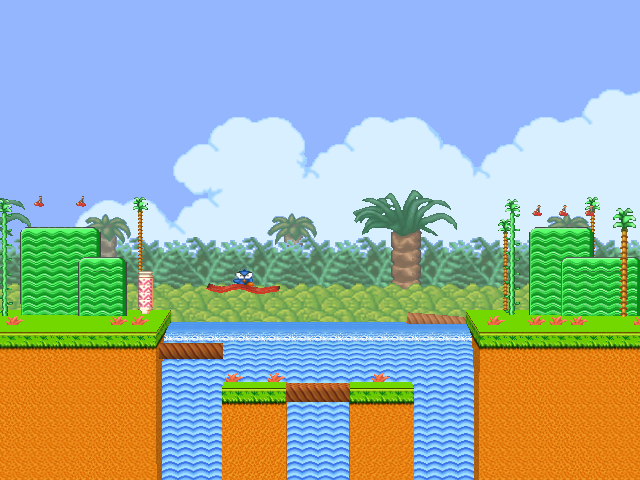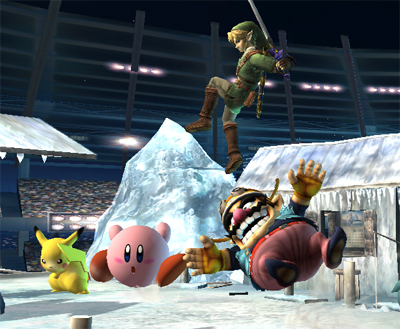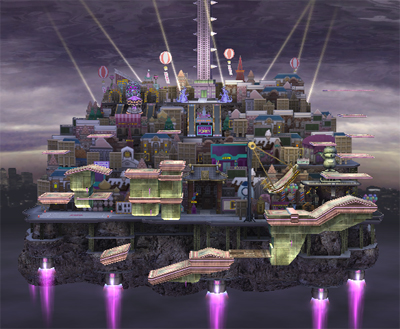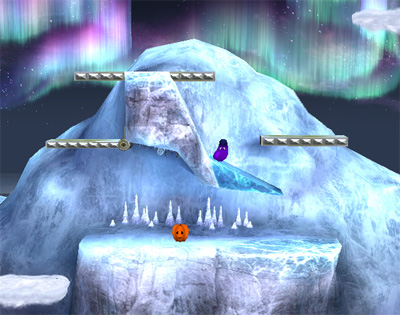Super Smash Bros. Brawl. Probably the most hyped up title in the series, it unfortunately ended up being the most disapponting installment to many because of its floaty and more casual gameplay. The game was full of content like crazy, and it was much more inventive than Melee arguably, but was more akin to something like Mario Kart. The infamous slipping mechanic was introduced, the Smash Ball final move was kind of unbalanced, much of the development time was used to build an immense, for a fighting game, story mode, and in general, this was Nintendo's attempt to expand even more the fanbase. It succeeded, might as well admit it, and now that Smash 4 is out, I believe that Brawl was a necessary step for the franchise and it could've been a lot worse considering the general direction Nintendo was taking in the Wii era.
All this obviously had a big impact in the stage selection of the game. We're going to analyze 29 stages with this part of the write-up, the biggest number of new stages introduced in a single game if you count 3DS and WiiU as two separate games (which I do). To these ones 12 stages are to be added for their return from Melee, but we're not going to talk about them again. The 29 Brawl stages are the most diverse, original, gimmicky and, to be fair, interesting added in the series so far. Sakurai avoided the Battlefield layout to be repeated like a plague, and the two/three simpler stages have still something going on to differentiate them from the rest. This, as we'll find out, is not always a good thing, because in Brawl, I feel, is when Sakurai decided to sacrifice some quality design just to be able to say that this particular stage is something Smash Bros. hasn't seen yet.
Since the game is kind of frowned upon by most of the fanbase, I doubt a lot of these stages are liked except the obvious ones (Smashville and Lylat Cruise), but it would be a disservice to say that they're all bad. In my opinion, actually, a lot of the Brawl stages are pretty great and fun.
Touring stages, scrolling stages, transforming stages, there's even a stage in which you play minigames! Sakurai went all out and it's not surprising: the development time for Melee was a little under 2 years and look what he was able to achieve, so with 6 whopping years to work with this time around, it was expected something as crazy as Brawl.
The best part about Brawl's stage selection in my opinion is that Sakurai started to get comfortable about representing franchises which didn't have a playable character in the game (this was even bigger in Smash 4), and he wasn't so adamant about forcing himself in keeping the stage selection similar for all characters. Star Fox and F-Zero for example get only one new stage, which is understandable considering the state the series were and are now. Mario though gets 5 even if no new characters are added for the franchise (Dr. Mario is actually cut), but expands beyond the main Mario series. Luigi's Mansion and Mario Kart join the fray adding a much needed variety instead of the usual.
In general, I understand why Sakurai did what he did, and I loved Brawl back then, the amount of new content was enough for me to abandon almost completely Melee even though I liked the gameplay less, and I think this is where Smash Bros. really started to research a lot in its source material for everything new which was going to be introduced, or almost at least. Let's start with a good example of a stage, one of my favorites of the bunch actually:
Delfino Plaza (Super Mario Sunshine)
A new kind of touring stage, Delfino Plaza doesn't follow a line, but is placed instead in a central HUB, and the main platform that moves, where the battle takes place, positions itself in various parts of the arena, each one with a completely different layout. The central HUB where this stage is located is actually, well, an HUB: Delfino Island from Sunshine makes a return after 4 years, and it was the biggest breath of fresh air for Mario ever. I love Sunshine, to this day I consider it the most underrated Mario game ever, so seeing Brawl giving attention to a place which we'll probably never see again was surprising, especially since next year would be Super Mario Galaxy's advent to our homes.
Delfino Plaza doesn't offer any hazard, the complexity of the stage is relegated only to the interchangeable platforms where you find yourself fighting on. You can get a nice and smooth area with a little bit of sea left and right like the start of the level, the part composed by small columns near the lighthouse, or the giant Shiny tower you see on the image.
It's a perfect stage because it introduces both new players to Smash, presenting them a variety of situations unrivaled by many if not all the other stages in the game (randomly, there are nine different zones to land in, and even the platforms that bring you there change their configuration even if slightly), and also updates Melee players with new mechanics like swimming.
The stage, also, looks pretty damn beautiful even on Wii. The upgrade in HD was fantastic, but Delfino Plaza cements itself as a much more interesting HUB world for Smash, certainly more than 64's Peach's Castle, one that I think will be surpassed only by the upcoming Odyssey on Switch.
The main concept of the stage works perfectly to represent general big landscapes from a certain game. It would've been kind of underwhelming if this stage was sitting simply on a little space of Delfino Plaza, a limitation of previous games, but with this new idea it is possible to see every road, house, I mean, every detail basically from the town. It's a perfect formula which will return obviously, even if not always when expected.












































